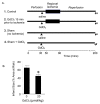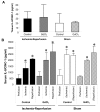Gadolinium decreases inflammation related to myocardial ischemia and reperfusion injury
- PMID: 20003243
- PMCID: PMC2799407
- DOI: 10.1186/1476-9255-6-34
Gadolinium decreases inflammation related to myocardial ischemia and reperfusion injury
Abstract
Background: The lanthanide cation, gadolinium (GdCl3) protects the myocardium against infarction following ischemia and reperfusion. Neutrophils and macrophages are the main leukocytes responsible for infarct expansion after reperfusion. GdCl3 interferes with macrophage and neutrophil function in the liver by decreasing macrophage secretion of inflammatory cytokines and neutrophil infiltration. We hypothesized that GdCl3 protects against ischemia and reperfusion injury by decreasing inflammation. We determined the impact of GdCl3 treatment for reperfusion injury on 1) circulating monoctye and neutrophil counts, 2) secretion of inflammatory cytokines, and 3) influx of monocytes and neutrophils into the myocardium.
Methods: Rats (n = 3-6/gp) were treated with saline or GdCl3 (20 mumol/kg) 15 min prior to a 30 min period of regional ischemia and 120 min reperfusion. Sham rats were not subject to ischemia. Blood was collected either after 30 min ischemia or 120 min reperfusion and hearts were harvested at 120 min reperfusion for tissue analysis. Blood was analyzed for leukocytes counts and cytokines. Tissue was analyzed for cytokines and markers of neutrophil and monocyte infiltration by measuring myeloperoxidase (MPO) and alpha-naphthyl acetate esterase (ANAE).
Results: GdCl3 did not affect the number of circulating neutrophils prior to ischemia. Two hours reperfusion resulted in a 2- and 3- fold increase in circulating monocytes and neutrophils, respectively. GdCl3 decreased the number of circulating monocytes and neutrophils during reperfusion to levels below those present prior to ischemia. Furthermore, after 120 min of reperfusion, GdCl3 decreased ANAE and MPO activity in the myocardium by 1.9-fold and 6.5-fold respectively. GdCl3 decreased MPO activity to levels below those measured in the Sham group. Serum levels of the major neutrophil chemoattractant cytokine, IL-8 were increased from pre-ischemic levels during ischemia and reperfusion in both control and GdCl3 treated rats. Likewise, IL-8 levels increased throughout the 3 hour time period in the Sham group. There was no difference in IL-8 detected in the myocardium after 120 min reperfusion between groups. In contrast, after 120 min reperfusion GdCl3 decreased the myocardial tissue levels of macrophage secreted cytokines, GM-CSF and IL-1.
Conclusion: GdCl3 treatment prior to ischemia and reperfusion injury decreased circulating monocytes and neutrophils, macrophage secreted cytokines, and leukocyte infiltration into injured myocardium. These results suggest GdCl3 decreased monoctye and neutrophil migration and activation and may be a novel treatment for inflammation during ischemia and reperfusion.
Figures






References
-
- Crawford MH, Grover FL, Kolb WP, McMahan CA, O'Rourke RA, McManus LM, Pinckard RN. Complement and neutrophil activation in the pathogenesis of ischemic myocardial injury. Circulation. 1988;78:1449–1458. - PubMed
LinkOut - more resources
Full Text Sources
Research Materials
Miscellaneous

